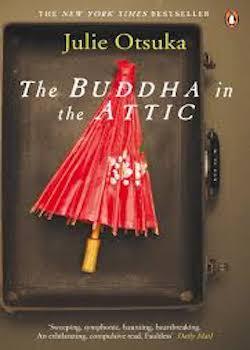The Buddha in the Attic

By Julie Otsuka
Penguin (2013)
ISBN-13: 978-0241956489
Review by Azmina Sohail
The title of Julie Otsuka’s novel The Buddha in the Attic is reminiscent for many literary critics of the noted feminist book, The Madwoman in the Attic, a study of the representation of women in the nineteenth-century and their struggle for autonomy in the literary world. Otsuka, now over three decades later, uses this title to present in fictional form the struggle for Japanese identity in America at the height of the Second World War.
Based on the real life stories of Japanese immigrants who came to America in the 1900’s, Otsuka’s novel is essentially a story by women for women. With a distinctive poetic narrator, she traces the migration of Japanese women from their homeland in the East to the West with the promise of the “American Dream.” Travelling across oceans with the intention of a successful marriage, their transition into domesticity, the difficulties and fear of integration and their slow demise, evacuation and eventual disappearance, this story is essentially the voice of the voiceless immigrant.
What stands out is Otsuka’s rhythmic narrative style; with the narrator’s all-seeing, all-knowing persona, it has the ability to detail the experiences of different women into one collective story. As if one woman is telling the story of hundreds of others. As if one woman is telling only her story. And as if one woman is listening to several stories at once; a peculiar amalgamation of them all. It is this and the plurality of pronouns used that evokes a poignant sense of sisterhood. When travelling ‘on the boat we had to make choices,’ when having children ‘our husbands had nothing to do with them’ and when leaving ‘some of us left weeping.’ The style is an underestimated and powerful literary tool that illustrates a collective sense of isolation and fear in a foreign land.
Thematically Otsuka’s story makes use of and personifies Edward Said’s theory of the ‘Oriental Other.’ Said’s stance of the Western perception of the “strange” and “exotic” Easterner is skilfully reversed. It is the immigrants who question their Western counterparts; ‘in the beginning, we wondered about them constantly…how were they able to tell each other apart…did they really hang dishes on their walls…and have locks on their doors.’ They wondered ‘to whom did they pray? What did they dream of?’ and if they ‘saw a man in the moon and not a rabbit?’ Perhaps in both defence and defiance of orientalism, Otsuka is conveying the questions of these immigrants in a respectful and intelligent manner. Instead of acknowledging any “barbaric” and “savage” practices, the Japanese women question the simple everyday practices of the “Other.”
The tactful exploration of immigrant cultural assimilation also allows the reader to reflect on its relevance today. With a recent resurgence of racism in the West and ethnic cleansing in the East, The Buddha in the Attic shows us that the problems with social integration is still very much alive. The novel reminds us that ethnic minorities, religions and cultures – notions that very much exemplify the diversity of life – have somehow become “incompatible” with the modern world. Dictatorial leaders and governments akin to those of the Second World War have embedded this idea into the masses causing a widespread fear and rejection of people.
In the novel, the propaganda becomes so strong that the Japanese soon begin to suspect their own people of political play; ‘they said our houseboys were intelligent agents in disguise’ and ‘our gardeners were all hiding shortwave radio transmitters.’ Despite their husbands help, ‘still, we were unprepared. Suddenly to find ourselves the enemy.’ In the same manner, various ethnic minorities today have become distrusting of each other; people who once held the same shared values and beliefs now become suspects to not only the outside world but to themselves.
In its final chapter the narrator switches its perspective to the “everyday” American citizen who carefully conveys the disappearance of their immigrant neighbours. Their traces being left behind with ‘abandoned cars on driveways…houses are boarded up and empty’ and businesses ‘shuttered…with official notices nailed to telephone poles…already beginning to tatter and fade.’ Some miss them and some are relieved but over time the memories of their Japanese neighbours begin to fade until eventually they can no longer recall their names; a haunting reflection of the reality of death.
Julie Otsuka’s novel of the immigrant experience is beautifully written. Its powerful narrative encapsulates the lives of a forgotten people still alive in the memories of Japan. It confronts the issue of immigrant integration head-on, holding up a mirror to contemporary society and its treatment of displaced populations. It tells us that no matter what, all immigrants experience the same sense of fear and hope; two emotions every human being will face. The novel is a salute to all the people who have experienced this type of fear and an eerie reminder that history is repeating itself. Ethnic cleansing is a reality and must be combatted, even if it means defying the biggest and most dangerous powers the world has ever seen.

